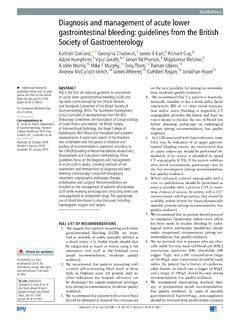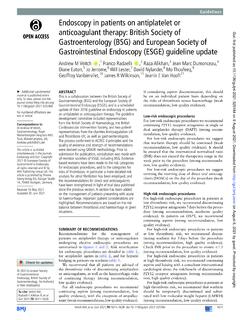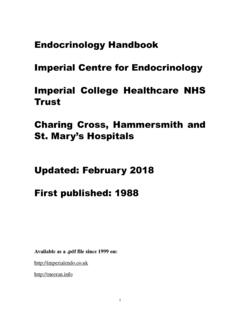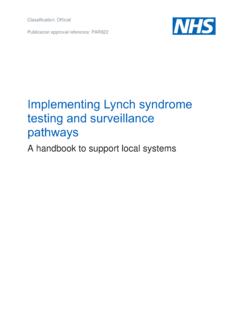Transcription of Guidelines for the management of oesophageal and …
1 Guidelines for the management of oesophageal andgastric cancerWilliam H Allum,1 Jane M Blazeby,2S Michael Griffin,3 David Cunningham,4 Janusz A Jankowski,5 Rachel Wong,4On behalf of the Association of UpperGastrointestinal Surgeons of Great Britain and Ireland, the British Society ofGastroenterology and the British Association of Surgical OncologyINTRODUCTIONOver the past decade the Improving OutcomesGuidance (IOG) document has led to servicere-configuration in the NHS and there are now 41specialist centres providing oesophageal and gastriccancer care in England and Wales.
2 The NationalOesophago-Gastric Cancer Audit, which wassupported by the British Society of Gastroenter-ology, the Association of Upper GastrointestinalSurgeons (AUGIS) and the Royal College ofSurgeons of England Clinical Effectiveness Unit,and sponsored by the Department of Health, hasbeen completed and has established benchmarks forthe service as well as identifying areas for past decade has also seenchanges in the epidemiology of oesophageal andgastric cancer. The incidence of lower third andoesophago-gastric junctional adenocarcinomas hasincreased further, and these tumours form the mostcommon oesophago-gastric tumour, probablyreflecting the effect of chronic gastro-oesophagealreflux disease (GORD) and the epidemic of increase in the elderly population with signif-icant co-morbidities is presenting significant clinicalmanagement challenges.
3 Advances in under-standing of the natural history of the disease haveincreased interest in primary and secondaryprevention strategies. Technology has improved theoptions for diagnostic and therapeutic endoscopyand staging with cross-sectional imaging. Resultsfrom medical and clinical oncology trials haveestablished new standards of practice for bothcurative and palliative interventions. The quality ofpatient experience has become a significantcomponent of patient care, and the role of thespecialist nurse is fully intergrated.
4 These manychanges in practice and patient management arenow routinely controlled by established multidis-ciplinary teams (MDTs) which are based in allhospitals managing these OF THE GUIDELINESThe original Guidelines described the managementof oesophageal and gastric cancer within existingpractice. This paper updates the guidance toinclude new evidence and to embed it within theframework of the current UK National HealthService (NHS) Cancer revised guidelinesare informed by reviews of the literature andcollation of evidence by expert recommendations are listed.
5 The sections ofthe Guidelines are broadly the same layout as theearlier version, with some evidence provided indetail to describe areas of development and tosupport the changes to the recommendations. Theeditorial group (WHA, JMB, DC, JAJ, SMG andRW) have edited the individual sections, and thefinal draft was submitted to independent expertreview and modified. The strength of the evidencewas classified guided by standard of evidenceIa: Evidence obtained from meta-analysis of rand-omised controlled trials (RCTs).
6 Ib: Evidence obtained from at least one : Evidence obtained from at least one well-designed controlled study without : Evidence obtained from at least one other typeof well-designed quasi-experimental : Evidence obtained from well-designed descrip-tive studies such as comparative studies, correlativestudies and case : Evidence obtained from expert committeereports, or opinions or clinical experiences ofrespected of recommendationsRecommendations are based on the level of evidencepresented in support and are graded Arequires at least one RCT of good qualityaddressing the topic of Brequires the availability of clinical studieswithout randomisation on the topic of Crequires evidence from category IV in theabsence of directly applicable clinical OF RECOMMENDATIONSP revention<There is no established chemoprevention role forupper gastrointestinal
7 (UGI) cancer, and trialsare currently assessing this (grade C).<The role of surveillance endoscopy for Barrett soesophagus or endoscopy for symptoms remainsunclear, and trials are currently assessing this(grade B).Diagnosis<All patients with recent-onset dyspepsia overthe age of 55 years and all patients with alarmsymptoms (whatever their age) should bereferred for rapid access endoscopy with biopsy(grade C).1 Department of Surgery, RoyalMarsden NHS Foundation Trust,London, UK2 School of Social andCommunity Medicine, Universityof Bristol, Bristol, UK3 Northern Oesophago-GastricUnit, Royal Victoria Infirmary,Newcastle upon Tyne, UK4 Gastrointestinal Oncology Unit,Royal Marsden NHS FoundationTrust, London, UK5 Department of Oncology,University of Oxford, Oxford, UKCorrespondence toWilliam H Allum, Royal MarsdenNHS Foundation Trust, FulhamRoad, London SW3 6JJ.
8 11 April 2011 Accepted 17 April 2011 Published Online First24 June 2011 Gut2011;60:1449e1472. <A minimum of six biopsies should be taken to achievea diagnosis of malignancy in areas of oesophageal or gastricmucosal abnormality (grade B).<Endoscopicfindings of benign stricturing or oesophagitisshould be confirmed with biopsy (grade C).<Gastric ulcers should be followed up by repeat gastroscopyand biopsy to assess healing and exclude malignancy (grade B).<Patients diagnosed with high grade dysplasia should bereferred to an UGI MDT for further investigation (grade B).
9 <High resolution endoscopy, chromoendoscopy, spectroscopy,narrow band imaging and autofluorescence imaging are underevaluation and their roles are not yet defined (grade C).Staging<Staging investigations for UGI cancer should be co-ordinatedwithin an agreed pathway led by a UGI MDT (grade C).<Initial staging should be performed with a CT includingmultiplanar reconstructions of the thorax, abdomen and pelvisto determine the presence of metastatic disease (grade B).<Further staging with endoscopic ultrasound in oesophageal ,oesophago-gastric junctional tumours and selected gastriccancers is recommended, but it is not helpful for the detailedstaging of mucosal disease (grade B).
10 <For T1 oesophageal tumours or nodularity in high gradedysplasia, staging by endoscopic resection should be used todefine depth of invasion (grade B).<Positron emission tomography (PET)-CT scanning should beused in combination with endoscopic ultrasound (EUS) andCT for assessment of oesophageal and oesophago-gastricjunctional cancer (grade B).<Laparoscopy should be undertaken in all gastric cancers andin selected patients with lower oesophageal and oesophago-gastric junctional tumours (grade C).Pathology<Diagnosis of high grade dysplasia in the oesophagus andstomach should be made and confirmed by two histopathol-ogists, one with a special interest in gastrointestinal disease(grade C).















